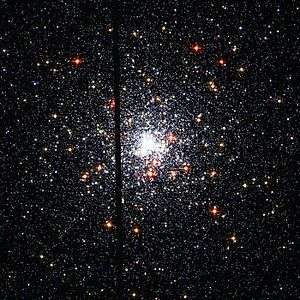NGC 6624
| NGC 6624 | |
|---|---|
|
The globular cluster NGC 6624. Credit Hubble Space Telescope | |
| Observation data (J2000 epoch) | |
| Constellation | Sagittarius |
| Right ascension | 18h 23m 41s |
| Declination | −30° 21′ 39″ |
| Distance | 25.8 ± 1.1 kly (7.91 ± 0.34 kpc) |
| Apparent magnitude (V) | 7.6 |
| Apparent dimensions (V) | 8.8 arcminutes[1] |
| Physical characteristics | |
| Metallicity | = -0.56 ± 0.27[2] dex |
NGC 6624 is a globular cluster in the constellation Sagittarius. It was discovered on 24 June 1784 by the astronomer William Herschel. It is given an apparent magnitude of 7.6 to 8.5.[3] Six pulsars are known in NGC 6624. The first of these to be discovered was PSR J1823-3021A. This globular cluster also contains 4U 1820-30, a low-mass X-ray binary with an orbital period of only 11.5 minutes.
NGC 6624 is visible as a hazy spot with a small telescope, and appears as a star-like object with binoculars. Its core appears significantly condensed.[1] It is located 0.8 degrees southeast of the star Delta Sagittarii,[4] and is about 1.17 kpc (3.8 kly) from the Galactic center.[2]

Map showing location of NGC 6624
References
- 1 2 O'Meara, Steve (2007). Steve O'Meara's Herschel 400 Observing Guide. Cambridge: Cambridge University Press. p. 236. ISBN 978-0-521-85893-9.
- 1 2 Sofue, Yoshiaki. The Central Regions of the Galaxy and Galaxies. Netherlands: Kluwer Academic Publishers. p. 37. ISBN 0-7923-5061-8.
- ↑ It is given a diameter of 6 to 8.5 arcminutes, and class VI with stars magnitude 14 and dimmer. It is less than a degree southeast of star Delta Sagittarii. O'Meara, Stephen James (2007). Deep Sky Companions: Hidden Treasures. Cambridge University Press. p. 452.
- ↑ Bakich, Michael E. (2010). 1001 Celestial Wonders to See Before You Die: The Best Sky Objects for Star Gazers. Springer. p. 249. doi:10.1007/978-1-4419-1777-5. ISBN 978-1-4419-1776-8.
- Robert Burnham, Jr, Burnham's Celestial Handbook: An observer's guide to the universe beyond the solar system, vol 3, p.1557
External links
This article is issued from Wikipedia - version of the 12/3/2016. The text is available under the Creative Commons Attribution/Share Alike but additional terms may apply for the media files.
